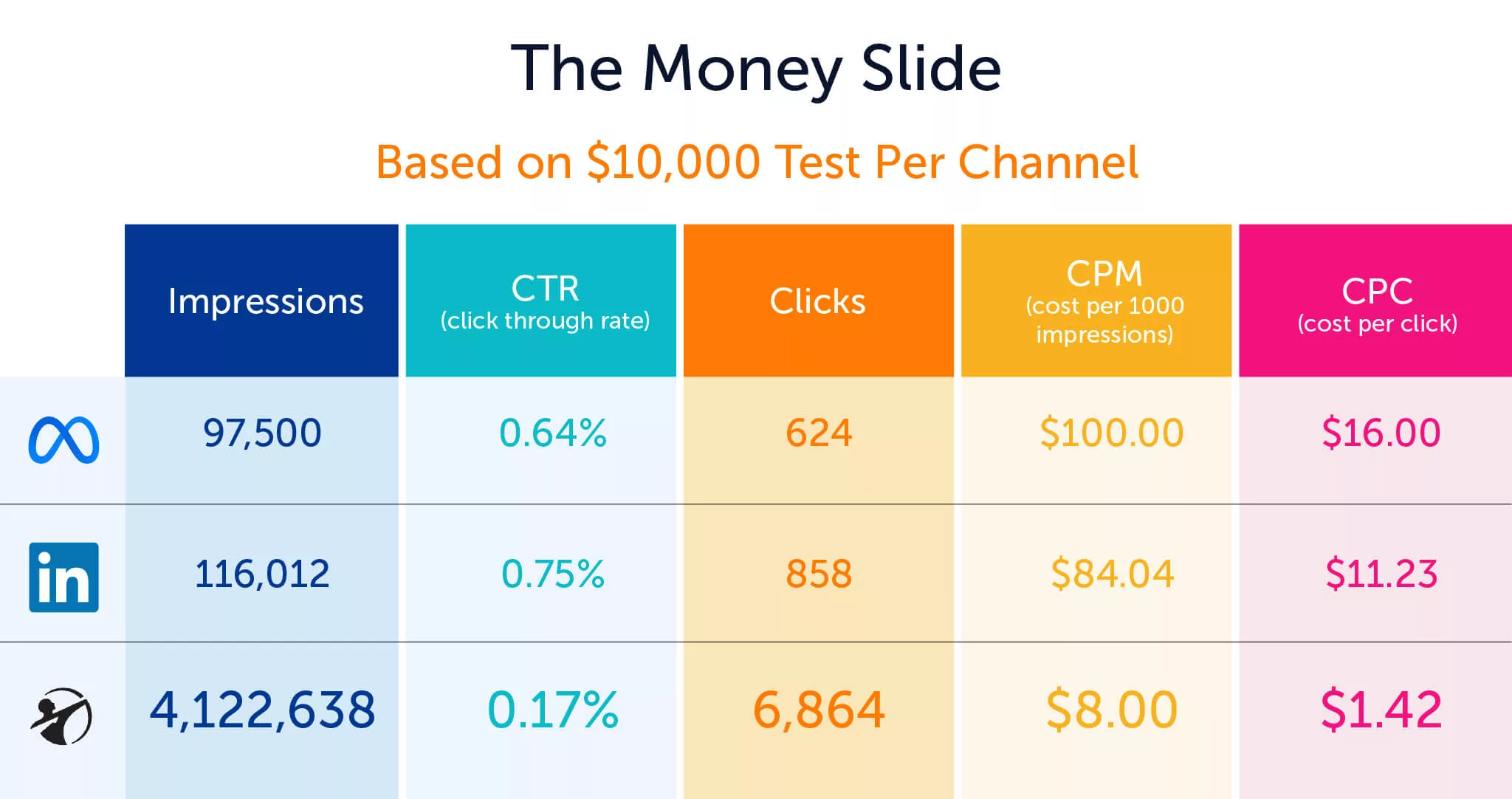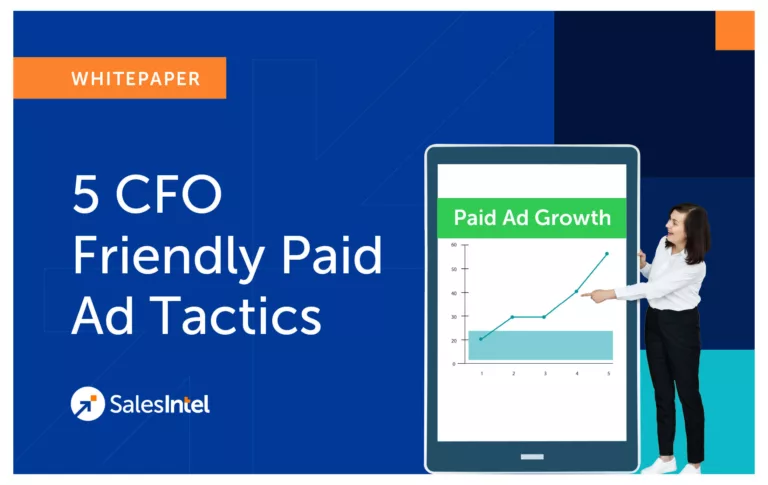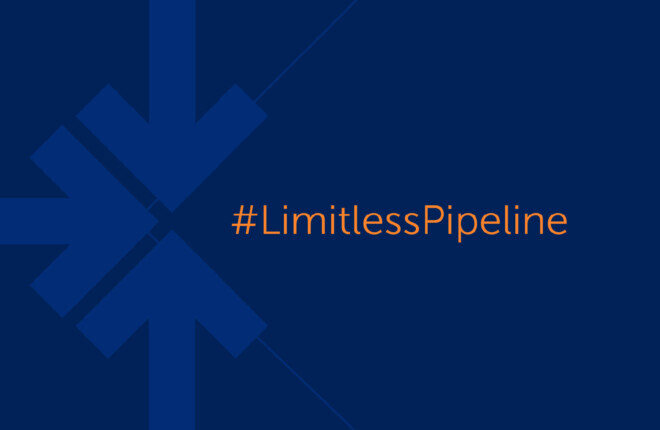Investing in paid ad channels can be a dangerous game. Google Search ads can grab prospects towards the end of their buying journey, but you can only invest as much as people search for your solution. Otherwise, you’ll go over budget trying to chase the chance of a couple more leads from barely-connected search terms.
Social media ads can also struggle to have a positive ROI. Everyone is competing for views and clicks. With a smart strategy, your marketing team can still make social media ads work. But, the intense bidding competition and increasing clutter of social media platforms mean you’ll struggle to scale with additional investment.
So, does that mean you should only run limited-budget ad campaigns to grab the low-hanging fruit? Our CMO, James Lamberti, ran a test to see how we could have the highest ROI for paid ads and, ideally, be able to scale incoming leads as well.
We’ll go into the details of the experiment towards the end. But I want to jump ahead and tell you what we discovered.
We found we needed to focus on a paid ad channel a lot of you might be overlooking: programmatic B2B display ads. Programmatic ads are how you display ads all over the web that aren’t on your major sites like Facebook and LinkedIn.
I’ll explain.
Programmatic Ads Run Off Your Data
Maybe you’ve tried programmatic ads in the past, and they didn’t do much for you. Or, maybe you’re wondering if they’re so great, why am I only hearing about this option now?
That’s because in the past, marketing teams have struggled to feed their ideal audience to the programmatic platform for ad targeting. Your ICP (ideal client profile) is the essential starting point. You need to review all of your CRM data based on firmographics, technographics, and buying intent to find your ideal, current customers. You’re not looking for who you want to be your future customers, but the specific company details that increase your chances of currently winning that customer.
Your ICP should describe your qualified, attainable, target customer. If your CRM doesn’t have all the details necessary to find your ICP, you can use your data provider to fill in the blanks and get the full picture.
Once you have your ICP definition, you can feed it into SalesIntel (or your data platform of choice) to find all the accounts that currently fit your ICP. In theory, you now have a list of qualified target customers with a strong chance of closing a deal. Your target list is the starting point for cost-effective paid advertising and a useful lead-generation channel.
You are not feeding all your current customers and lookalike audiences to the ad platform or guessing what your ideal customer would look like and giving the platform those parameters. Both approaches will go too wide and lead to wasted spending on unqualified prospects seeing ads. By using your ICP account list for all your ad targeting, you position every dollar spent on ads to be getting the attention of a qualified prospect.
Having your ICP definition and target accounts is a prerequisite for programmatic B2B display ads to be effective.
How Do Programmatic Ads Work?
What are programmatic ads, and where do they show to viewers?
Programmatic ads require that you take your ICP data and audiences and run them through a demand-service platform (DSP) or directly through an ad network that uses automation to place your ad on whatever sites your target audience might be visiting. They could be small specialist websites or major sites like CNN and ESPN.
Programmatic is an environment where high-quality publishers can’t sell all of their digital inventory. They’ll give their extra digital inventory to DSP or a programmatic ad platform. Your ad will then appear in a high-quality location outside the clutter of most other B2B advertising on social media or B2B-focused sites.
The benefit of programmatic ads is being able to track down your target audience wherever they are. You don’t have to wait for them to search or hope they’re on Facebook. Your ad will find them.
Why are Programmatic Ads Beneficial?
Unliked with search ads, you’re not going to see people clicking and moving forward with a deal. But, display ads build awareness with your ICP audience and can be used for specific messaging to specific segments. You’re not throwing up a billboard on the highway and hoping some of the people that see might be your audience. You’re having your ad appear on your ideal prospects’ doorstep.
They’re likely not going to be in the market yet. That’s okay. Programmatic B2B display ads are designed to be a middle-of-the-funnel tactic meant to take qualified prospects (qualified thanks to knowing they match your ICP) and build your reputation and awareness with them. Let them know that you solve a problem they have. Maybe this is the first time hearing that their problem can be solved. As they become problem-aware, they’ll see your ads, remember you, take action, and eventually become a buyer.
Your marketing team and leaders will likely be immediately onboard to try programmatic ads as a middle-of-the-funnel approach. But, your sales team and CFO might not see the immediate benefit of display ads.
The ads can’t immediately be connected to a prospect taking action like a paid search ad. Explain to them that anyone who matches your ICP is a potential buyer, and the display ads push them down the funnel. Prospects don’t show up out of thin air, ready to buy. Display ads work like webinars, whitepapers, and even this blog you’re reading. They are a way to engage your target audience.
Give your marketing team time for the ads to have an impact. It might be three, six, or nine months before someone seeing your ads is ready to buy. But marketing generally doesn’t instantly win customers. Like a sales rep making a note to follow next year, marketing is setting up pipeline. The product demand, brand recognization, and problem awareness epiphany will pay out down the road.
Measure Your Blended Attribution
If you can’t immediately see the benefits of B2B display ads, how do you know they’re doing anything? How can you justify the spend?
Your CFO and other leadership would likely prefer to measure ads based on clicks. But ask them when the last time they clicked on an ad was. Their behavior is that they don’t click on display ads. Clicks are great for measuring ad success. Search ads run on clicks, but display ads aren’t meant to drive action and clicks immediately.
Instead, you want to measure the impact of display ads with a blended attribution model. People will look at ads and read them. People frequently see an ad and immediately search for the brand instead of clicking the ad. The behavior you want to measure is ad view, and then you connect it to a prospect’s future actions when possible.
Other B2B ad channels can’t get you the same number of views and brand awareness either because they can only reach a limited number of your prospects or because they are oversaturated channels. The more people try to use LinkedIn to show ads, the more expensive LinkedIn ads will be. But, programmatic ads can reach your audience across the web (and even apps), and the cost is lower because there is less competition for the ad space.
Let’s get to the experiment I originally mentioned that inspired investing more in programmatic ads. Our CMO wanted to prove programmatic display ads were valuable to our own CFO, so he ran a test where he spent $10,000 each on Meta, LinkedIn, and programmatic ads to compare the results. You can see the results below for yourself.
Meta and LinkedIn got around 100,000 impressions and had higher click rates. But, the impressions with programmatic were a magnitude higher than the competition. We had over 4,000,000 impressions. Even though the click rate was much lower, the sheer number of people we reached meant we still ended up with a lower CPM and CPC. Programmatic gives you the most bang for your buck when creating mid-funnel awareness. You’re creating the demand that search ads and sales can harvest later.

Programmatic B2B display ads are extremely cost-effective when you’re highly targeted. Our new routine is to use programmatic channels to get 5-10 impressions every month within the 26,000 companies in our ICP. The brand awareness trickles down to better results for all our other marketing and sales efforts. Without our ICP and quality data feeding the ads, they wouldn’t be effective. But, because of the accuracy and careful selection of our targeting data, we can see these ads having an impact.
You’ll need a holistic, blended attribution model for your marketing team. If you rate all your marketing channels based on last-touch conversions then it’s going to look like paid ads barely move the needle. But, if you track how many prospects view an ad before converting elsewhere and keep track of your general lead generation trends, you’ll see improvements across the board. Middle-of-the-funnel paid ads increase the audience size and speed of conversions everywhere else.
When it comes to paid advertising, you can still use Meta, Google, and LinkedIn. Those are all channels you’re going to test and optimize over time, but we would advise you to look at and try the programmatic world. We’ve found it a great way to get coverage and reach outside of the noise of the typical B2B channels.
Takeaways
Let me summarize what we’ve learned and your next steps.
- Traditional paid advertising for search and social media struggles to scale because of the limited nature of your audience and the platforms.
- Programmatic B2B display ads can reach a magnitude higher number of prospects for the same cost by not being limited to your audience’s behavior or time spent on a specific site.
- Use your data to build your ICP and find a list of your target accounts. Go slow, use accurate data, and get your foundation right.
- Feed your target audience into your programmatic ad platform, be a little patient, and use blended attribution to see how B2B display ads impact your channels.
There is no such thing as a single silver bullet or magical marketing and sales channel to solve all your problems. Still, programmatic marketing is an option to explore and see if it can finally make paid advertising a successful and cost-effective marketing tactic.






